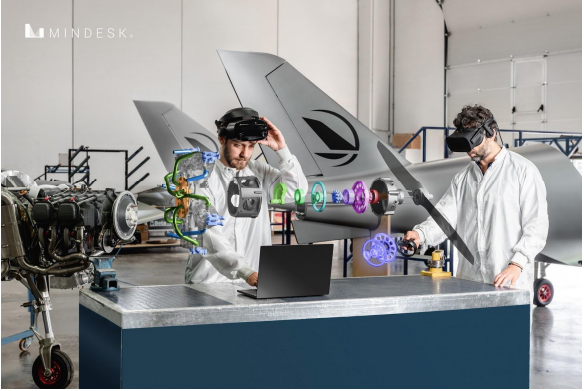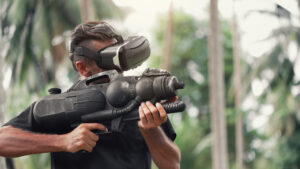The VR industry’s breakout year is ‘just the beginning’

Virtual reality (VR) has had a whirlwind year in 2020
Virtual reality has been hyped for several years but 2020 has been a breakout year for the sector.
It entered the mainstream when Facebook acquired VR headset company Oculus for US$2.3 billion back in 2014.
At the time Mark Zuckerberg said:”Oculus has the chance to create the most social platform ever, and change the way we work, play and communicate.”
It’s fair to say this hasn’t happened yet – at least beyond gaming. But slowly VR is beginning to expand its horizons as companies realise what it makes possible.
VR uses range from helping people customise their cars to providing architects and engineers with another perspective on a proposed project.
VR behind AR/MR but thriving thanks to COVID-19
Like other sectors surging during COVID-19, VR prospered because locked down consumers had little other choice.
“COVID has been devastating but it has sharpened almost everyone’s adoption of technology – from Zoom simply to run meetings, to augmented reality (AR) and mixed reality (MR) to try and rise above the noise,” explained David Shering, the founder & creative director of industry player Handbuilt Creative.
AR and MR are slightly different to VR. AR overlays virtual objects on the real-world environment and MR anchors virtual objects to the real world.
While VR is slightly behind AR and MR, Shering is confident about VR’s future.
“VR is definitely becoming more mainstream – particularly due to Oculus Quest being such a runaway success, albeit in the gaming sector,” he explained.
“That being said, I think Augmented Reality (or more correctly Mixed Reality) is poised to steal the show almost overnight.
“Apple’s big push into Augmented Reality (via ARkit and adding LIDAR to their devices) signals very strong pathways for the future.
“We know that Augmented Reality wearables will replace the smartphone, and we might see that occur much earlier than people expect – perhaps [in] the next 6 to 18 months.”
ASX’s only pure play VR stock soars in 2020
The ASX’s only pure play is Vection (ASX:VR1) and it has had a breakout year.
In March, in the middle of the COVID-19 market crash, it bought 3D design platform Mindesk. Mindesk helps engineers design projects (such as houses and industrial products) from scratch using virtual reality.
It offers bi-directional real time links across other design software, allowing users to seamlessly switch to virtual reality from desktops.
Mindesk relies on its own graphic engine rather than a third party’s. This facilitates greater performance and customisation than the competition.

Last month it excited investors, joining two VR programs in the space of a week – one run by Facebook and the other run by Microsoft and building information modelling software maker Autodesk.
Both programs help VR companies accelerate the path of their programs to the market.
Vection has also excited investors with early forays into the healthcare sector.
In September it signed on an Italian hospital to trial its technology to help navigate endoscopic surgeries and access data.
Shares sat at only 2 cents in March and are currently at 12 cents – making it a 5-bagger.
Vection (ASX:VR1) share price chart
‘We’re just at the beginning’
Speaking with Stockhead from Perth yesterday, Vection director and chief operating officer Gianmarco Orgnoni said it had been a big year but his company was just at the beginning.
He noted the enterprise segment was another opportunity for VR and the sky was the limit.
“We are probably the only company worldwide that focuses on VR/AR for enterprise use. And yes, we’ve had some very significant success in the industry,” Orgnoni said.
“I would say it is a market in its infancy, I think COVID has accelerated significantly the market interest in this technology.
“But I think there’s a lot of work to be done and I think we’re just at the beginning and great adoption is going to be seen in the next couple of years.”
Vection is anticipating revenue generation to come very soon.
“We’re positioning ourselves with strategic initiatives that will provide for strong revenue growth in the second half of the [financial] year,” Orgnoni said.
“And obviously as the market grows the opportunities will become more and more significant for us and for our shareholders as well.
“We’re not discounting the possibilities of growing organically as well.
“If the opportunity arises to grow different segments of the industry that are going to provide us with an opportunity to cross-sell and up-sell customers with VR/AR solutions, that will be a strong addition to our value proposition.”
Another VR player?
The ASX, and arguably markets globally, are starved of the VR sector – or at least pure play stocks.
But one other ASX stock making forays is indoor entertainment venue operator Indoor Skydive (ASX:IDZ). Last month, it too went ballistic after announcing a standalone virtual reality themed venue.
The company already ran VR entertainment options at its two indoor skydiving venues using the brand name Freak Entertainment. But having a standalone venue clearly depicted it is serious about VR.
While Indoor Skydive has not responded to Stockhead’s requests for comment, it hinted this won’t be all.
The company signed an agreement with Westfield owner Scentre Group (ASX:SCG) for a 14-month pilot program intended to cumulate with further retail sites for Freak Entertainment to be established next year.
Indoor Skydive (ASX:IDZ) share price chart
Related Topics
UNLOCK INSIGHTS
Discover the untold stories of emerging ASX stocks.
Daily news and expert analysis, it's free to subscribe.
By proceeding, you confirm you understand that we handle personal information in accordance with our Privacy Policy.








